新编外贸英语口语教程 廖瑛主编
- 格式:ppt
- 大小:159.00 KB
- 文档页数:14
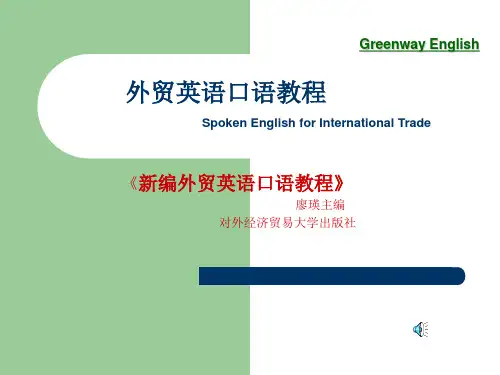
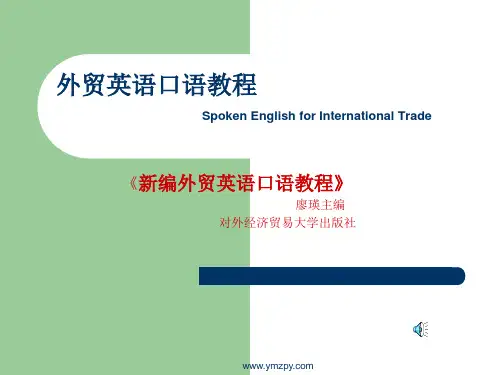
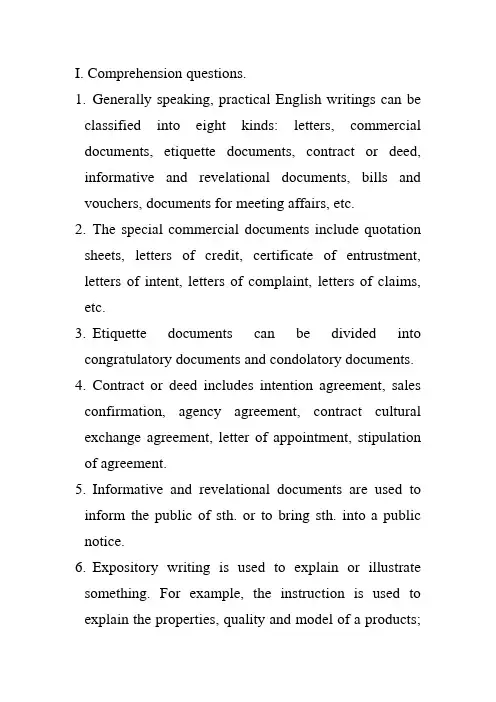
I. Comprehension questions.1. Generally speaking, practical English writings can be classified into eight kinds: letters, commercial documents, etiquette documents, contract or deed, informative and revelational documents, bills and vouchers, documents for meeting affairs, etc.2. The special commercial documents include quotation sheets, letters of credit, certificate of entrustment, letters of intent, letters of complaint, letters of claims, etc.3. Etiquette documents can be divided into congratulatory documents and condolatory documents.4. Contract or deed includes intention agreement, sales confirmation, agency agreement, contract cultural exchange agreement, letter of appointment, stipulation of agreement.5. Informative and revelational documents are used to inform the public of sth. or to bring sth. into a public notice.6. Expository writing is used to explain or illustrate something. For example, the instruction is used to explain the properties, quality and model of a products;caption is used to illustrate the film. Trademark is used to mark the brand of a product.7. Some stipulations of agreement, such as joint communiqué, joint statement, joint pledge, contract, etc. have the function of stipulation, which means that these documents are binding on every sides signed, and that the side who breaks the terms bear political, economical or moral responsibility.8. It means that to almost all the practical English writings, the first function is to inform or to remind the counterpart or the public of a certain thing or public affair. Besides expository writing has explanatory function. In a word; the so-called “Function of Information and Understanding” is to inform somebody of something and let him or her to act as the practical English writing told.9. The Function of voucher is the function of evidence. All the documents to external association almost have function of voucher. Especially all kinds of contracts, agreements, certificates, orders, letters of credit, bills, receipts, I.O.U., shipping documents, letters of introduction, letters of reservation, welding certificate,etc., have obvious function of vouchers.10. In order to write the practical English writings, the author should have a good command of standard modern English, all kinds of social knowledge, knowledge of technical terms, knowledge of social psychology and knowledge of various profession, such as secretary, management, business theory and practice, etc.11. Because practical English writing has its specific language style, that is, the essential language characteristics which are called the seven Cs: completeness, concreteness, clearness, conciseness, courtesy, consideration and correctness.12. Because a practical English writing is successful and functions well only when it contains all the necessary information to the readers, and answers all the questions and requirements put forward by the readers. The so-called “completeness” is to see to it that all the matters are stated or discussed, all the questions are answered or explained, and all information are provided.13. In a general and vague message, everything seemsto be mentioned, but actually, few are fully expounded. The readers only have a vague impression of what you try to achieve, so he or she is at a loss how to react upon reading your message. Especially for contracts, agreements, announcements notices, found, poster, advertisements and business letters calling for specific reply, as offer, inquiring trade terms, etc., the “concreteness” must be always stressed as the general or vague message will cause unnecessary troubles and disputes.14. The so-called “clearness” is to make sure what you write is so clear that it can’t be misunderstood. As a writer, you should have a concrete idea in your mind of what you are going to achieve. Only a clear mind can express clearly. In order to make what you write clear, you should pay attention to choose the concise and straight-forward expressions and try to avoid using the words and sentences equivocal in meaning; pay attention to the position of the modifier; pay attention to the object of the pronoun and the relations between the relative pronoun and the antecedent; pay attention to rationality in logic, the variety in the sentencestructure, the compact in plot and coherence in meaning; pay attention to the logicality of the fall text.15. “Conciseness” means you should clearly express what you need to do in a short and pithy style of writing as possible as you can without sacrificing completeness, concreteness and courtesy.16. The definition of the “You-attitude” is to put yourself in the position of the recipient and take into consideration his demand, hope, interests and so on. 17. Because a letter expressed in the way of refined and courteous urbane can make yourself set up an honest and enthusiastic image with good artistic appreciation and professional ethics in the eyes of the readers who will be glad to cooperate with you and serve you wholeheartedly.18. If the sentence is rewritten like this: We assure you that the goods will be shipped by July 20, it will be better, because it explains the problem in a positive way.19. Correctness refers much more than that of grammar, punctuation and spelling of words, which are the basic elements. The writer should also bear in mind thefollowing: 1) choose the only accurate facts, words and figures; 2) take a matter-of-matter attitude to clearly state what you will say. Don’t over-state or understate; 3) pay attention to the correct understanding and using the commercial terms and jargons.20. Because if the practical English writings for international business is not correct, they may be misunderstood and even go astray. Practical English writings for international business, especially, business letters often are bases for various commercial documents such as contracts and agreements, so they are concerned with the rights, obligation, etc. of the both sides of a trade, the fact of which must call special attention from writers.II. Rewrite the following sentences and make them correct, positive and polite.1. For the past two years, no order has been given to us.2. We are afraid we can’t comply with your request.3. Would you please compare our goods with those of other firms?4. We hope you will effect a full settlement of our claim.5. We would like to make it clear that for furthertransaction, D/P will only be acceptable if the amount involved for each transaction is not up to U.S. $1 000 or its equivalent in RMB at the conversion rate than prevailing.6. We regret to inform you that the goods shipped by SS East Wind arrived in such an unsatisfactory condition that we can not take delivery, but lodge a claim with you.7. We request your immediate payment.8. We presume that there must be some reason for your having trouble with this article.9. We gladly refund when the returned items are clean and resalable.III. Compare the two letters, you will find Letter B is written in positive way. Then try to translate them into Chinese.Letter A译文:我们收到了你们9月21日关于来自西非和东南亚顾客对硫铵的询价信。
![新编外贸英语口语教程(第四版)教学课件 廖瑛 廖越英 (4)[4页]](https://uimg.taocdn.com/cf63103142323968011ca300a6c30c225901f0c7.webp)
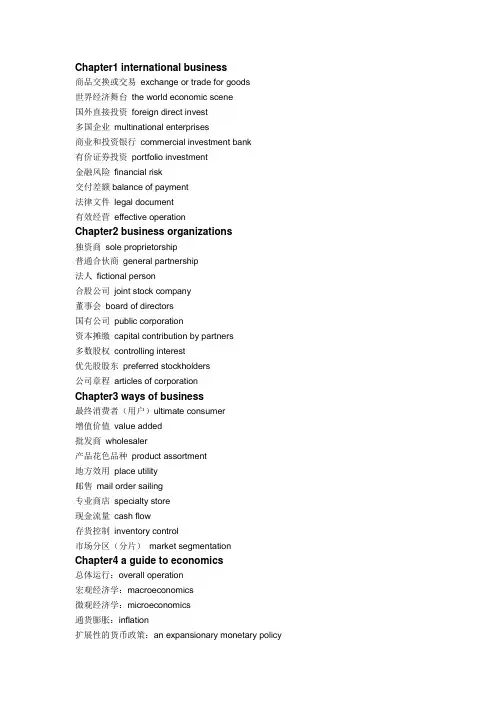
Chapter1 international business商品交换或交易exchange or trade for goods世界经济舞台the world economic scene国外直接投资foreign direct invest多国企业multinational enterprises商业和投资银行commercial investment bank有价证券投资portfolio investment金融风险financial risk交付差额balance of payment法律文件legal document有效经营effective operationChapter2 business organizations独资商sole proprietorship普通合伙商general partnership法人fictional person合股公司joint stock company董事会board of directors国有公司public corporation资本摊缴capital contribution by partners多数股权controlling interest优先股股东preferred stockholders公司章程articles of corporationChapter3 ways of business最终消费者(用户)ultimate consumer增值价值value added批发商wholesaler产品花色品种product assortment地方效用place utility邮售mail order sailing专业商店specialty store现金流量cash flow存货控制inventory control市场分区(分片)market segmentationChapter4 a guide to economics总体运行:overall operation宏观经济学:macroeconomics微观经济学:microeconomics通货膨胀:inflation扩展性的货币政策:an expansionary monetary policy紧缩性的货币政策:a restrictive monetary policy货币流通:currency circulation or circulation of money货币投放量:the size of money supply经济萧条:economic depression均衡数量:equilibrium quantityChapter5 the market economy市场经济:the market economy计划经济:planned economy股市:stock market经济力:economy forces供给力:supply forces需求力:demand forces经济体系:economic system市场价格:market price供求均衡:the equilibrium of supply and demand购买力:buying power供给量:quality supply价格体系:price systemChapter6 what is marketing营销观念服装零售商购买动机最终用户非赢利性机构采购制度产品规格招标低价产品可自由支配的收入多人挣钱型家庭价格和质量比较投币式自动售货机营销调研Chapter7 the marketing mix & product promotion 营销战略促销产品策划品牌名称市场总销售产品生命周期分销渠道中间商批发商促销技巧成功地进入国际市场熟悉外国文化的人们与顾客沟通的主要方式促销策略对他们广告竞赛的成功很关键特定的出口市场其他广告和促销的形式有价值的建议要设计得能吸引顾客的注意力海外销售代理广告对消费品的销售作用很大我们应该十分重视产品的包装不同国家具有不同的购买习惯一般说来,美国公司的广告费用要占销售额的5%以上电视是一种很有效的广告媒介Chapter8 international payment & settlementAlthough China has enacted the bill of exchange law,it would still be useful to know something about Article 3 of the Uniform Commercial Code(UCC)—Commercial paper of the United States since most of our international payment instruments are denominated in the U.S Dollar . Article 3 of the UCC defines the terms of commercial paper and set forth the rights and liabilities of all the parties who deal with drafts,checks,notes and certificates of deposit .If an instruments does not meet all the requirements listed at the beginning of this unit,it is not a negotiable one under the terms of the UCC,though the parties involved may still be willing to use and accept it. However,the “Non-negotiable instrument” is treated still as a negotiable instrument so far as its form permits. Since it lacks of negotiability,there can be no holder in due course of such an instrument. Any provision of any selection of the UCC—Commercial Paper peculiar to a holder in due course cannot apply to it. With this exception,such instruments are covered by all sections of the Article 3 of UCC.翻译:虽然中国已经颁布了票据法,但了解一下统一商法法典——美国商业票据的第三款仍是有用的。
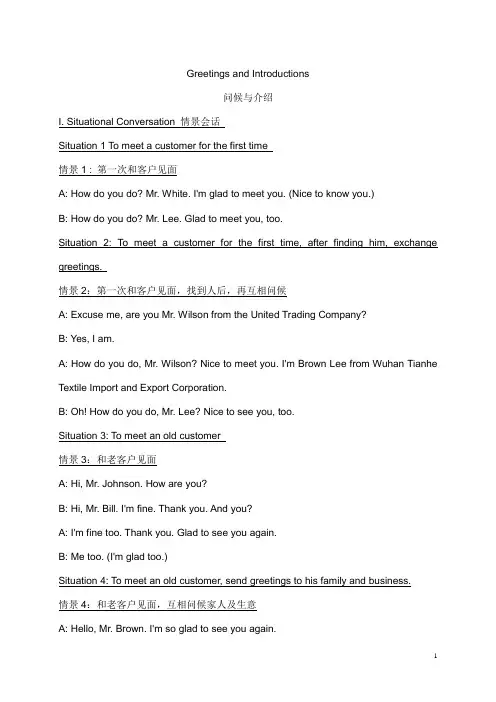
Greetings and Introductions问候与介绍I. Situational Conversation 情景会话Situation 1 To meet a customer for the first time情景1 : 第一次和客户见面A: How do you do? Mr. White. I'm glad to meet you. (Nice to know you.)B: How do you do? Mr. Lee. Glad to meet you, too.Situation 2: To meet a customer for the first time, after finding him, exchange greetings.情景2:第一次和客户见面,找到人后,再互相问候A: Excuse me, are you Mr. Wilson from the United Trading Company?B: Yes, I am.A: How do you do, Mr. Wilson? Nice to meet you. I'm Brown Lee from Wuhan Tianhe Textile Import and Export Corporation.B: Oh! How do you do, Mr. Lee? Nice to see you, too.Situation 3: To meet an old customer情景3:和老客户见面A: Hi, Mr. Johnson. How are you?B: Hi, Mr. Bill. I'm fine. Thank you. And you?A: I'm fine too. Thank you. Glad to see you again.B: Me too. (I'm glad too.)Situation 4: To meet an old customer, send greetings to his family and business.情景4:和老客户见面,互相问候家人及生意A: Hello, Mr. Brown. I'm so glad to see you again.B: Hi, Lisa. How are you?A: I'm fine, thank you, and you?B: I'm fine, too.A: How are your family?B: They are all right, thank you.A: And how's your business?B: It's very good.Situation 5: To meet a old friend情景5:与老朋友见面A:Good morning. Mr. Smith.B: Good morning, Mr. Lee.A: How are you getting along? (How have you been recently? )B: I'm quite well, thanks. And how are you?A: I'm fine too. It couldn't be better.其他:A: Is everything OK here?B: Everything is fine. I can't complain.其他:A: Long time no see. So, what are you up to lately? / What have you been up to lately? B: The same things. / Same as usual / Nothing special.情景6:You introduce a new customer, Mr. Bob from the United Trading Co., Ltd to your boss, Mr.Lee. After being introduced, Mr. Lee and Mr. Bob exchange greetings, name cards and then offer the customer something to drink.A: Mr. Bob, May I introduce my boss, Mr. Lee. And Mr. Lee, this is Mr. Bob from the United Trading Co. Ltd,B: How do you do, Mr. Bob? I'm very glad to meet you.C: How do you do, Mr. Lee? Glad to meet you, too.B: Please have a seat. (Sit down, please. / Please be seated). Make yourself at home. C: Thank you. I'm so glad to be here.B: Here is my name card, and may I have yours?C: Yes, this is mine.B: Would you like something to drink? (What do you like to drink, coffee or tea?)C: Coffee, please.B: How would you like your coffee?C: I like it black. (Coffee with milk and sugar.)B: O.K., the coffee will be with you soon.C: Thank you.Unit 1 Receiving Foreign Businessmen第一单元:迎接外商Lesson 1- Making Flight Reservations第一课预订机票Situational Conversation 情景会话情景:来自曼彻斯特的商人Wilson先生要到中国参加天津进出口商品交易会。
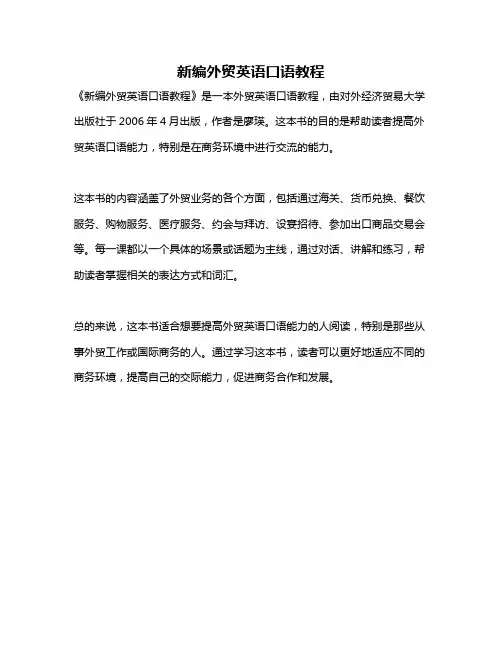
新编外贸英语口语教程
《新编外贸英语口语教程》是一本外贸英语口语教程,由对外经济贸易大学出版社于2006年4月出版,作者是廖瑛。
这本书的目的是帮助读者提高外贸英语口语能力,特别是在商务环境中进行交流的能力。
这本书的内容涵盖了外贸业务的各个方面,包括通过海关、货币兑换、餐饮服务、购物服务、医疗服务、约会与拜访、设宴招待、参加出口商品交易会等。
每一课都以一个具体的场景或话题为主线,通过对话、讲解和练习,帮助读者掌握相关的表达方式和词汇。
总的来说,这本书适合想要提高外贸英语口语能力的人阅读,特别是那些从事外贸工作或国际商务的人。
通过学习这本书,读者可以更好地适应不同的商务环境,提高自己的交际能力,促进商务合作和发展。